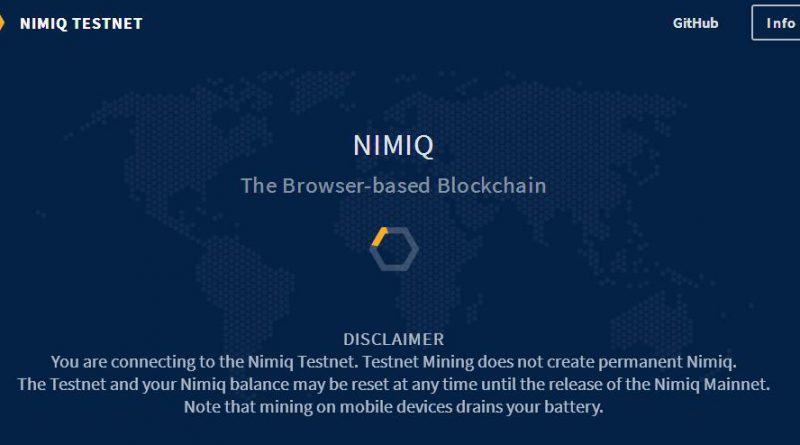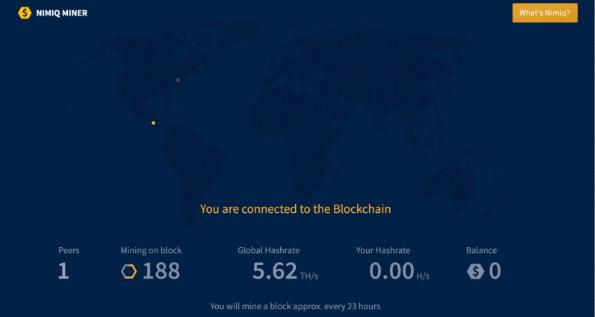Meet Nimiq, World’s First Browser-Based Blockchain
In simpler terms, Nimiq is an open source and fully decentralized browser-based blockchain payment protocol that lets any website to synchronize with the blockchain network, validate a blockchain, query account balances and create and send transactions. It will let users make peer to peer payment with each other over the browser, securely and with faster time for transaction confirmations, without the need to download massive data as is with other cryptocurrencies.
It makes things simpler for cryptocurrency developers, merchants, and general users.
Developers can use the client over the browser to develop related applications over the blockchain. Users can install (by way of a single click online) web-based nodes over the browser and send payments to merchants through the browser without the need to download and run massive data and run complicated nodes on their computers or mobile devices.
As it is, if it were a secure solution as argued, then a browser-based blockchain payment protocol would increase mass adoption for cryptocurrencies.
Of course, the major challenge for internet connected blockchain applications and tech has largely been their security and it will be interesting to see how this project works out. However, for Nimiq, there is no doubt that there will be a large user learning curve in terms of how to ensure top-notch security over this browser-based blockchain tech.
It uses browsers' native language JavaScript.
The system uses browsers to establish consensus with the network and enable peer-to-peer payments from within the browser without the need for the user to connect to the blockchain through a trusted third party.
It promises browser-based mining at the click of a button, a built-in browser wallet, global instant peer-to-peer transactions that do not need confirmations; as well as fast, easy and cheap exchange of crypto with fiat money.
Launch of Mainnet is happening on December 2017 but the core expository is available here for developers who want to check it out and test an application using the blockchain. Here's there telegram channel and White Paper for the project.
The company launched the Nimiq Betanet live in June and received more than 12,000 browser-based nodes from all over the world within twelve days of launching.
What exactly does it offer?
1. A web-based wallet in beta
Users will get a wallet that use browser's library. This wallet will work or integrate with paper-based cold wallets that can afford the user some physical security.
2. Peer-to-peer exchange features
Peer-to-peer based cross-chain transactions that allow you to acquire the tokens by exchanging tokens across different blockchains without the blockchain escrow. Cross-chain transactions allows Nimiq to use exchange services around Bitcoin and Ethereum without the user having to pay the high fees associated.
Although this would be one way of acquiring the tokens, there are other options including the company establishing partnerships with VISA payment services to create a VISA-to-Nimiq exchange. The other option, they say, would be creating a centralized Peer-to-Peer Exchange like localbitcoins.com.
3. Nimiq Betanet, a preview of the Nimiq protocol
The company is using Betanet to learn how Nimiq protocol behaves in the wild and to gather data on its agility and feature usability, among other things. This blockchain could be reset anytime leading to loss of your Betanet Nimiq Tokens and therefore cannot be used to create permanent Nimiq Tokens.
4. SHA256 as Proof-of-Work mining
The platform is based on a mixture of Ethereum and Bitcoin platforms.
Users will be able to earn using an advanced version of PoW SHA256 -- it's all a drawback because it uses a lot of electricity, but there is a reason to that for now: The Web Cryptography API only supports that technology -- the NIST curves for elliptic curve signatures. The company will shift to PoS if it becomes supported.
If you are a serious miner, then you would need to run mainly the Backbone nodes so you can get good performance and convenience.
These nodes will, however, require an encrypted connection via SSL in order to connect to the network. In that case, you would need a domain and an SSL certificate but the company will add in a dynamic DNS and Letsencrypt packaged in the client installer in order to make it easy to access domains. You might also need to run the node over the standard 443 port if connections to non-standard ports is unable to work.
The network uses two nodes; Backbone Nodes (these are based on NodeJS and run on servers and communicate with each other to establish browser-to-browser WebRTC connections) and Browser Nodes (that are free and built upon browser engines and they communicate with the network by establishing a WebSocket connection to at least one Backbone Node). Backbone Nodes continue to establish browser-to-browser peer connections after the first connection using the Backbone Node as signaling server. Browser Nodes can also act as signaling server for further browser-to-browser connections.
Browser Nodes serve as light-clients, allows users to remit transactions with Western Union and MoneyGram and other companies, and do not participate in the network as miners but they are used in establishing consensus quickly to prove balances in accounts and send transactions in the network.
5. Blockchain data gets stored to your drive
We begun by expressing fears that hot wallets and internet connected transactions can be dangerous and your Bitcoins, Nimiq, Ethereum or other cryptos could be wiped in a minute. Not to worry though because the project is trying to add top notch security features to avoid the risks that come with browser-based technologies.
In particular, they use IndexedDB API to have data from blockchain saved in your drive.
The blockchain is compressed with the Mini-Blockchain scheme to allow the web browser to store data (websites cannot store gigabytes of data) and in beta testnet, the private key is stored un-encrypted and is deleted when you clear browser history.
6. Support for cold wallets on the way
With Chrome's Storage Persistence API, the data and private key does not disappear when you clear the browser data. However, the private key is stored encrypted and you will be able, with Nimiq, to back-up the key in a printed paper wallet.
The company will also support cold wallets through Web USB or Web Bluetooth.
Although new blocks gets generated after a minute, that could change to 15 seconds as is the case with Ethereum.
If anything is unclear in this article, then you can plug into their YouTube channel to learn more. There is also a blog run by the company.
Other tech explained
There is a lot of tech talk about the cryptocurrency in this article, but in simplicity, Nimiq network solves the challenge of translating blockchain components into the browser tech using WebRTC and WebSocket connections.




